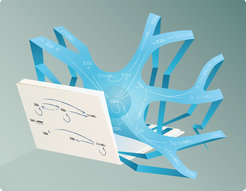De-centralizing the central dogma: mRNA translation in space and time
In a current review published in Molecular Cell, scientists at the Max Planck Institute for Brain Research discuss how local translation and its spatiotemporal regulation have expanded our conceptual understanding of genetic information flow within a cell (the Central Dogma). The authors review the mechanisms and molecules involved in mRNA localization and translation within subcellular domains across a variety of cells and organisms.

An originally unpublished outline sketch by Francis Crick in 1956 (Cobb 2017, https://doi.org/10.1371/journal.pbio.2003243.g001, Credit: Wellcome Library, London) depicting a proposed flow of information in biology, represented by solid and broken arrows. It indicates that information can flow from DNA to RNA to protein, that both DNA and RNA can likely replicate themselves, and proposes that direct DNA to protein and RNA to DNA transfer seems likely although unproven. Boldly it considered the reverse, a flow from protein back to any other form as impossible. The concept of localized translation expands this one-dimensional view by assigning spatial coordinates to each of these macromolecules within the cell, depicted via a folded paper version of a neuron. While DNA is constrained to the nucleus, both RNA and proteins can exist throughout the cell, but the unidirectional sequence of events remains unchanged as indicated by the very same arrows. .
“As our understanding of the cell interior has grown, we have come to appreciate that most cellular operations are localized - they occur at discrete and identifiable locations or domains”, state the paper’s authors Bourke et al. “These cellular domains contain the enzymes, machines and other components necessary to carry out and regulate these localized operations.”
In their review, newly published in Molecular Cell, the scientists discuss the features of one such operation: the localization and translation of mRNAs within subcellular compartments observed across cell types and organisms. They describe the conceptual advantages and the “ingredients” and mechanisms of local translation and focus on the nature and features of localized mRNAs, how they travel and get localized and how this process is regulated. Furthermore, they evaluate the current understanding of the protein synthesis machines (ribosomes) and their cadre of regulatory elements - the translation factors.












